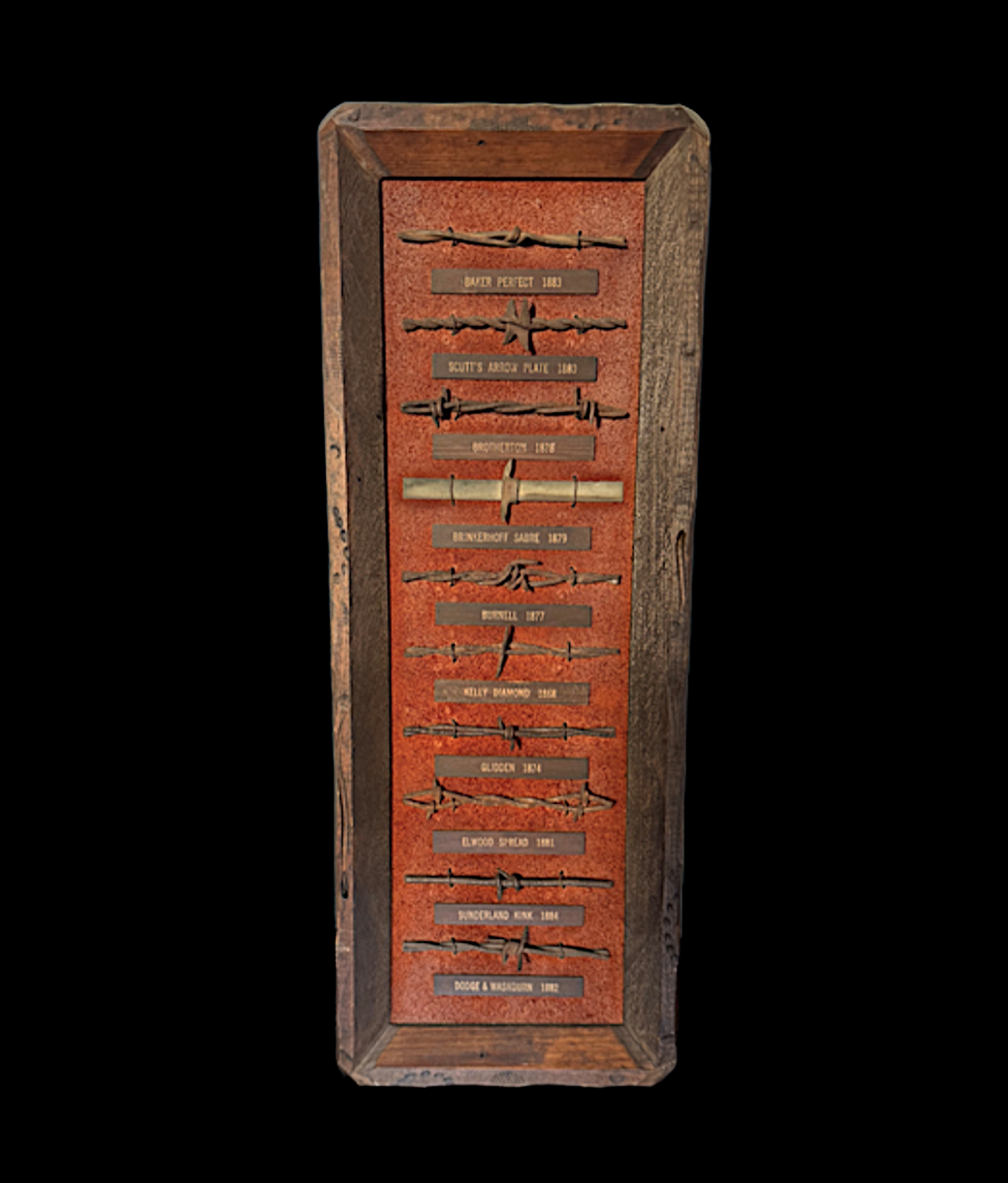

Title: Ten Framed Antique Rare Barbed Wires With Patent Dates
Shipping: $29.00
Artist: N/A
Period: 19th Century
History: Art
Origin: North America > United States
Condition: N/A
Item Date: N/A
Item ID: 701
Devils Rope: A remarkable collection of ten antique, rare barbed wires, carefully mounted on leather and framed in one handcrafted folk art wooden frame. Each wire displays its unique patent date, showcasing the ingenuity of the 1800s in the United States. This rare and spectacular collection represents a piece of history, highlighting the evolution of barbed wire manufacturing. Approximate dimensions: 18" x 6 3/4”. A perfect addition for collectors or history enthusiasts! Barbed wire, often called "Devil's Rope," has been a vital tool since its invention in the 19th century. In the 1800s, it revolutionized land management by providing an affordable and efficient way to fence large tracts of land, especially on the open plains, enabling farmers and settlers to protect crops and livestock while transforming the American West. During the 1900s, barbed wire extended beyond agriculture, playing a significant role in military applications such as trench warfare during World War I and securing boundaries in prisons and industrial sites. Today, barbed wire remains a practical solution for fencing in rural areas, but it has also taken on symbolic and artistic significance, reflecting themes of confinement, protection, and historical ingenuity.
The History of Barbed Wire in the 1800s Barbed wire, often referred to as "the Devil’s rope," played a transformative role in shaping the American West during the 19th century. Developed in response to the need for affordable and effective fencing, it became a crucial tool for farmers and ranchers. Early Concepts (Before the 1870s) Before barbed wire, farmers relied on wooden fences or natural barriers like stone walls and hedgerows to enclose their land. However, these were costly, labor-intensive, and unsuitable for the vast, treeless plains of the Midwest. The first attempts to incorporate sharp elements into fencing materials date back to the mid-19th century, but these designs were impractical or too expensive to mass-produce. The Turning Point: Patent Innovations In 1867, Lucien B. Smith of Kent, Ohio, was granted the first patent for barbed wire. He designed a simple method of attaching sharp points to wire, earning him the title of its "inventor." Barbed wire gained momentum in 1874 when Joseph Glidden, a farmer from DeKalb, Illinois, patented a design that twisted two wires together to hold sharp barbs firmly in place. This design was sturdy, effective, and relatively easy to produce, setting the standard for future barbed wire manufacturing. Barbed Wire and the Expansion of the West The invention of barbed wire coincided with the expansion of settlers into the western United States. The Homestead Act of 1862 encouraged settlement in the Plains, but farmers needed a cost-effective way to protect crops and livestock from roaming cattle. Barbed wire provided an affordable solution, enabling settlers to claim and secure land without the need for extensive wooden fencing. Conflict and the "Range Wars" The widespread adoption of barbed wire led to conflict between ranchers, who relied on open ranges for grazing, and farmers, who enclosed their land with barbed wire fences. These disputes escalated into the "range wars" of the late 1800s, marked by cut fences, destroyed property, and even violence. Despite resistance, barbed wire fundamentally changed the open range system, ushering in a new era of enclosed grazing and farming. Industrial Growth By the late 1800s, barbed wire production had become a thriving industry. Factories, primarily in Illinois, Texas, and Kansas, mass-produced various styles of barbed wire, with each manufacturer vying for dominance. Over 500 patents were issued for different barbed wire designs by the end of the 19th century, reflecting the innovation and competition in this field. Cultural and Historical Significance Barbed wire symbolizes the transition from the untamed frontier to the modern agricultural economy. It also had global implications, as its adoption spread to other parts of the world, influencing farming and land management practices internationally. Legacy Today, antique barbed wire from the 1800s is considered collectible folk art, with various designs reflecting the ingenuity and spirit of the era. It is a tangible reminder of the technological and social changes that reshaped the American landscape.